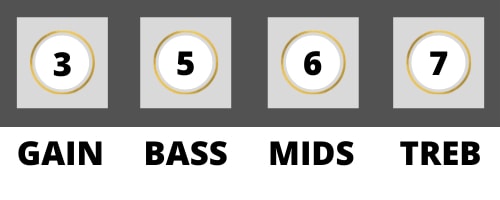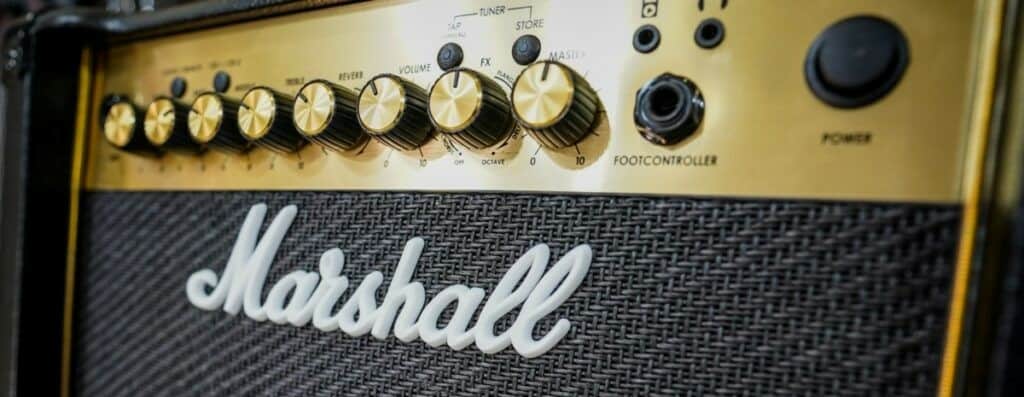Many great lead and rhythm guitarists have been in the band Eagles over the decades and many aspiring players have tried to emulate their tone. However, trying to dial in the right amp settings to sound like any band is no easy feat. In this article, I’ll be guiding you through the process of setting up your amp so you can get as close to their song with your current rig so you can play along to their classic hits.
Quick Guide to Eagles Amp Settings
To sound like Eagles on the electric guitar, start with the following amp settings:
- Gain: 2-3
- Bass: 4-5
- Mids: 5-6
- Treble: 6-7
- Reverb: 2-3

Keep in mind that these settings are just aimed to be used as a starting point. Unless you are using the exact same guitars, amps and effects as Eagles then it’s pretty much impossible to get the tone to be identical for a particular song.
However, I have designed this article to take you through the process of dialling in your amp settings to sound as close as possible Eagles regardless of your current rig.
The Basics
Before we look at some example amp settings for specific Eagles songs, it’s important to get a good grasp on the amp settings and effects which underpin their tone. We’ll take a look at the following sections of your amp:
- Gain
- EQ
- Effects
Gain
Before we jump into the numbers, you need to be clear about the type of amp you’re using: solid-state or tube (valve).
Most players reading this will have a solid-state amplifier which usually has two channels (clean and distorted) and a gain control (sometimes this will be called drive or distortion instead). Alternatively, you may have a tube amp instead. Make sure you search your amp online to work out which you own if you are unsure.
There are two approaches you can take with a solid-state amplifier. Firstly, you can use the clean channel and increase the gain (if your amp allows you to adjust the gain control on the clean channel). Or, you can use the distorted channel and keep the gain low.
Eagle’s typically don’t use much gain and have a lightly overdriven tone. If you go with the clean channel method, you’ll usually need the gain to be on 6-8 to begin with. However, if you use the distortion channel method then you may only need it to be on 2-3 for most songs. When soloing, you may need to turn this up a bit more.
If you have a tube amp then you’ll need to get it to the edge of break-up. Don’t push it any harder than it needs to be, you just want some light overdrive.
EQ/ Tone (Bass, Mids, Treble)
The next proportion of the amp we need to consider is the EQ section which is responsible for shaping the tone. On some amps, you’ll just be dealing with a single control named either EQ or tone, whereas other amps may give you independent bass, mids and treble controls.
- Bass: this adjusts the low-end frequencies and typically needs to be quite low for most Eagles songs. Start with this on 4-5 to begin with.
- Mids: this adjusts the mid-range frequencies and should be fairly moderate so start with this on 5-6.
- Treble: this adjusts the high-end frequencies and needs to be moderately high so dial this in at 6-7 to begin with.
If your tone is too harsh and bright, turn down the treble or increase the bass. If it sounds too muddy and muffled, turn down the bass and increase the treble. If you’re struggling to distinguish the guitar in the mix, then you’ll need to turn up the mids in most cases.
The pickups you have and the amp’s EQ emphasis will influence the settings you need so there isn’t a one-size-fits-all answer here.
If you have single coil pickups, then your tone may be a bit thinner and brighter, in which case you’ll need to increase the bass and mids. Whereas if you have humbucker pickups then you may need to increase the treble instead. The pickup placement will also affect this. The bridge pickup will sound brighter and clearer as there is more treble emphasis compared to the neck pickup which sounds warmer as it has more bass emphasis.
Make sure you play about with both the pickup selector and your amp settings to get the best tone possible. Experimentation is highly encouraged!
Also, for lead sections you’ll often need more treble and mids compared to rhythm playing when more bass may be useful to create a warmer tone.
Some amps also have other controls such as presence and contour. Check out my complete guide to amplifier controls to learn how to adjust these controls and many more to get the best settings possible.
Make sure you also check out the brand-specific amp controls guide which is relevant to you, to get the most from your rig:
- Fender Amp Settings
- Marshall Amp Settings
- Boss Amp Settings
- Orange Amp Settings
- Line 6 Amp Settings
- Vox Amp Settings
Effects
You don’t need tonnes of effects to get right tone here, but some effects are very useful to have. Some amps come with built-in effects but if you amp doesn’t come with any, then you can always use some effects pedals if you don’t mind investing more money into your rig.
I highly recommend getting a reverb pedal if your amp doesn’t have built-in reverb, as this is useful for pretty much every style of music.
- Reverb: this should be on at low-levels most of the time to provide more life and depth to the tone.
- Delay: this is useful for some solos and again helps to provide life and depth.
- Phaser: this effect is used in the “Hotel California” solo.
A boost or overdrive pedal can be useful to allow you to easily switch from rhythm to lead sections without adjusting your amplifier.

Sounding like Eagles isn’t just about your amp settings, it’s about your skills too.
Check out this 14 day free-trial for Guitar Tricks to access over 11,000 lessons and 1000 songs to become a better player today.
Amp Settings for Popular Eagles Songs
In this next section I’ll be going through some presets you can get a good starting point for some of Eagle’s most popular songs. It should hopefully go without saying at this point, but these example amp settings are just designed to be used as a starting point to get you on the right lines. It’s very likely that you’ll need to tweak them to get the tone just right, and the next section in the article will help with that.
Hotel California Amp Settings
Intro:
- Gain: 1
- Bass: 4
- Mids: 7
- Treble 7
- Reverb: 2
Verse/ Chorus:
- Gain: 3
- Bass: 4
- Mids: 7
- Treble 7
- Reverb: 2
Solo:
- Gain: 4
- Bass: 5
- Mids: 8
- Treble 8
- Reverb: 2
Lyin’ Eyes Amp Settings
- Gain: 2
- Bass: 4
- Mids: 5
- Treble: 7
- Reverb: 2
Take It Easy Amp Settings
- Gain: 2
- Bass: 4
- Mids: 6
- Treble: 6
- Reverb: 2
Life in the Fast Lane Amp Settings
- Gain: 4
- Bass: 5
- Mids: 6
- Treble: 5
- Reverb: 2
One of These Nights Amp Settings
- Gain: 3
- Bass: 4
- Mids: 6
- Treble: 8
- Reverb: 2
I’ve also made an article with example amp settings for over 40 popular guitar songs here to help you sound more like your favourite players.
Common Issues
As promised, in this next section I’ll address some common issues you may be having when trying to sound like Eagles and how to fix them.
Each “issues” comes with a list of multiple fixes, although it’s likely you won’t need to try them all. I recommend working through each adjustment in the order listed by making small adjustments and listening to the differences. This is the most efficient way to diagnose the problem and become more knowledgeable about your amp.
Thin Tone
- Increase the mids
- Increase the bass
- Increase the gain
Dry and Flat Tone
- Add more reverb
- Increase the mids
- Increase the bass
Tone Sounds Too Harsh and Bright
- Switch to the neck pickup if you are using the bridge or middle
- Decrease the treble
- Increase the bass
Lack of Sustain
- Increase the gain
- Increase the bass
- Increase the mids
- Use a compressor pedal
Here are some more articles you might find useful:
